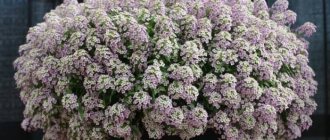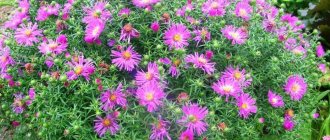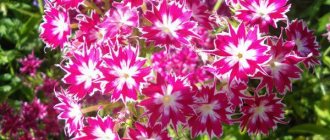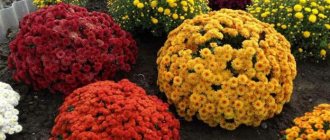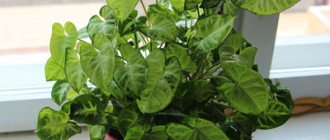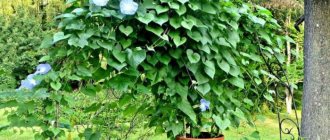Perennial
Before considering each type of climbing plant separately, you should understand the selection parameters.
To make a hedge pleasing to the eye, select young plants taking into account climate, humidity, light, soil composition - these are the most important parameters that guarantee you the most optimal selection. An important nuance is the fence itself. Thin and flimsy will not withstand heavy large vines. Self-clinging plants will not be able to climb on brick; you will have to make garters.
Advice! Do not plant several different species close to each other. You should especially be wary of ivy and hops - they will simply outlive decorative and more demanding neighbors.
Ivy
This climbing plant does not care where it grows, so it is often used in landscape design. Garden ivy survives in both hot sun and cool shade. At the same time, it grows and becomes a beautiful hedge in just a couple of months.
The plant is perennial, you will only have to tinker in the first year - the older the ivy gets, the less attention it requires. From the second year, the gardener's main task will be regular watering and pruning 2-3 times per season.
The photo shows an example of ivy growth
Hop
An excellent choice for those who do not like to care for plants, but want to decorate the garden with climbing plants for the fence. Large juicy leaves, fast growth, beautiful entwining of the fence - with hops this is guaranteed. In July-August the plant blooms profusely, and fragrant light cones are formed in place of the peduncle.
Important! Please note that getting rid of these two plants (hops, ivy) is incredibly difficult: digging or pulling them out is not enough; most likely, new shoots will appear from the ground for several more years.
Clematis
Annuals
Not all climbing plants tolerate frost successfully. If you live in a harsh climate, choose fast-growing annuals for the role of climbing plants for the fence.
Sweet pea
It will help to refine the fence and decorate decorative partitions, but it should be taken into account that it reaches only 2-3 meters in height. Grows in any conditions except wetlands. After planting, the plant requires regular standardized watering, high-quality fertilizing and special supports - otherwise it will simply crawl along the ground, occupying the area horizontally.
There are a large number of varieties of sweet peas - they differ mainly in the color and aroma of the buds.
The photo shows weaving climbing peas with shoots
Decorative beans
A light- and heat-loving climbing plant for a fence. Beans are distinguished by their decorative juicy greenery, which is why gardeners love them. It does not require special care, but for more lush growth and abundant landscaping, nitrogen fertilizers can be used.
Also take into account her love for watering: the hotter it is outside, the more often the hedge is watered, up to a daily repetition.
Advice! The fruits of decorative beans can be collected and even eaten - to make more of them, the shoots are regularly pinched.
morning glory
Annual climbing plants
Annuals are fast-growing, cascading vines with variegated flowers that are ideal for vertical gardening. Loaches, which live only 1 year, are distinguished by active growth, a voluminous leaf crown, long flowering and various shades of flowers. Plant growers recommend using several varieties of climbing flowering plants to build summer gazebos.
Ampelous gloxinia (azarina, lofos)
A profusely flowering annual vine with tubular, horn-like flowers. They reach 4-5 cm in length, have a light purple, lilac, purple, bright pink color and a whitish center. Azarina is thermophilic and light-loving, actively growing in width and length. With proper care, its flowering continues until the first frost. With the help of flexible leaf petioles, the flower wraps around narrow mesh supports.
Related article:
Spring primroses with names and photos
Visloporpnik rough
A rather finicky annual vine, but very popular among gardeners because of its double-pinnate leaves and long, bright flowering. Produces narrow-tubular flowers of purple-pink, bright orange, golden-yellow colors, collected in large loose clusters. With the help of tendrils, the flower clings to a support of any thickness and structure and sometimes rises up to 5 meters in height in one season. It is also grown in tubs on balconies and terraces. The yellow carp shows all its beauty if a site has been allocated for it in a sunny and warm place.
Sweet pea
A beautiful climbing outdoor flower that exudes a pleasant aroma. At the beginning of summer, its weakly branched winged stems are covered with moth flowers, red, pink, white, purple, and blue. Their diameter, depending on the variety, ranges from 3-8 cm. Over time, fruits similar to pea pods begin to appear from the inflorescences. If you trim them in time at the bud, the flower will continue to bloom until the first winter frosts. Sweet peas are attached to the support using small tendrils. A thin support, such as a carved wooden trellis or wire mesh, is more suitable for it. The plant prefers soil rich in humus, protected from the wind, well-lit places, and moderate watering.
Morning glory tricolor
It wraps itself in strong green hugs around everything that gets in its way. This representative of the Convolvulaceae genus grows well on vertical supports, walls, and high fences, creating a living, fragrant carpet.
Morning glory is a poisonous plant. It should not be planted where pets and children often walk.
At the beginning of summer, the annual loach is decorated with large funnel-shaped flowers (blue, violet, dark blue), reaching 8-10 cm in diameter. They are adjacent to large heart-shaped leaves. At night they close into buds, and in the morning they again amaze with their beauty. To maintain long-lasting luxurious flowering, the plant requires frequent watering, a warm sunny place without drafts and sandy-loamy soil with the addition of lime.
Related article:
5 beautiful flowers that will delight you with their blooms in August
Kobeya climbing
Landscape designers who know thousands of names of climbing plants for the garden especially highlight the annual kobeya or “bell-shaped grape”. In summer it blooms with purple climbing flowers with a pleasant honey aroma, shaped like large bells. The tenacious shoots of the plant entwine everything that gets in their way. They form into a thick vine and serve as ideal protection from prying eyes, bright sun and wind. It is best to secure this loach on a thin wire mesh. To maintain abundant flowering, it needs to be watered frequently.
Nasturtium (capuchin)
During the warm spring and summer, this herbaceous beauty grows up to 3 meters in height. It produces six-centimeter flowers, shaped like a gramophone horn, red, pink, orange, yellow, white. They exude a delicate aroma with a slight bitterness that repels flies and mosquitoes. Nasturtium loves sunny, warm places. Its new large shoots need to be tied up in time, and the plant itself needs to be periodically watered and fed with mineral fertilizers without nitrogen once a week until flowering begins.
Climbing hops
It tolerates shade perfectly and captivates with its bright green, large, lobed leaves on tall petioles. Although hops are not a climbing flowering flower, they please the eye with their volume. It can climb up to 4 meters up a plastered wall. It grows without problems on balconies and terraces, where twigs are installed, wire or twines are pulled. Sometimes this annual is grown in hanging flowerpots. So that it does not lose its decorative properties and does not stop growing, it is fertilized and exposed to the sun.
Related article:
Fragrant herbs in the garden
Winter-hardy
The evergreen climbing perennials from the first section survive even harsh winters without loss, but there are other options.
Honeysuckle
Ornamental species, such as honeysuckle, climb beautifully and bloom profusely throughout the season. But they have a drawback: the berries of these varieties (unlike shrubs) cannot be eaten, they are poisonous - so you should not plant them in an area where children can reach the fruits. Mature plants tolerate frosts without problems; they are not even removed from their supports. Young ones (up to 2-3 years) are best removed and covered at the end of the season.
Honeysuckle loves moist soil, so it is better to mulch the surface after planting to retain moisture. It grows best in the sun; the darker it is, the slower it will develop and bloom less.
Woodplier
As the name implies, this vine has more than enough strength and desire to live: without control, it will quickly kill other plants from the area and take over the territory. But with timely pruning, a hedge, even based on a picket fence or chain-link mesh, looks very decorative.
The tree plier survives the winter without much loss; you should not worry even if some of the shoots freeze. Thanks to its powerful root system, it will quickly recover with the arrival of warmer weather.
In the photo there is a wood plier entwined around an arch
Chinese lemongrass
This type of hedge has nothing to do with citrus fruits; the name was given solely because of the pleasant aroma of the fruit. Schisandra takes root and winters even in Siberian and Far Eastern territories, not to mention the mild winters of the central part of Russia. The only thing to keep in mind is that it does not like the sun, but it is ideal for decorating the shaded side of the fence.
Important! Schisandra stems are dried and brewed as tea - this drink has a restorative, energetic effect. Increases blood pressure, can even replace coffee.
Beautiful climbing flowers in the country
Especially decorative in multi-level dachas are plant compositions that stand out against the background of the building facade.
| Name | Characteristics and description |
| Nightshade bittersweet | An unpretentious and frost-resistant woody shrub crop with long shoots. It grows well not only in the middle zone, but also in Siberia and the Far East. A very fast-growing vine with dark green foliage and long-lasting blooms of lilac inflorescences, similar to the flowers of garden potatoes. Produces oblong, poisonous, bright red fruits |
| Calistegia downy | This type of vine belongs to closely related species of field bindweed, but is very different in both the size and shape of the flowers, reminiscent of lush and unusually attractive double roses. It reaches a height of three meters, which allows it to be widely used for decorating hedges, as well as creating green and abundantly flowering arches at the entrance to a building. The culture is aggressive and capable of growing very strongly, therefore, when planting in garden plots and summer cottages, it is necessary to limit the space for the growth of the root system. The liana is unpretentious, but tolerates shading quite hard |
| Lagenaria | It is characterized by extremely rapid growth and extremely active development of the above-ground part. It has very attractive, peculiar corrugated leaves, with the help of which large areas of fences, terraces and verandas, and the facade of buildings are decorated. Flowering is characterized by the formation of single flowers with an extremely delicate cream color. The fruits resemble cucumbers that are too large. For growth and development, the plant needs fertile soil, good sunlight and regular irrigation measures. |
| Blade mine | The liana is distinguished by very unusual decorative foliage, which is purple in color and has very pronounced veins, clearly visible against a lush green background. At the end of the season, the foliage of this vine-like crop changes color and may turn red, yellow or cream. It is preferable to grow on light sandy soils with good sunlight |
| Dolichos vulgaris | Dolichos are included in the list of the most unusual and very exotic garden liana-like crops. A special feature is the formation of large trifoliate foliage of a highly decorative purple color. The stems are purple in color. Blooms for a long time, with racemes of pink flowers that look like moths. The average length of shoots often exceeds four meters. The plant needs fertile soil and good lighting, as well as frequent watering and loosening |
| Scindapsus | Container or potted crop overwintering at home. The above-ground part grows and develops very quickly. It has juicy thickened green or variegated leaves, which are capable of accumulating a large amount of moisture when watered. Excessive irrigation measures contribute to quite noticeable evaporation of moisture through the foliage |
| Stephanotis | A container or potted crop that overwinters only at home. Flowering is relatively long, with delicate snow-white flowers that have an incredibly pleasant and delicate, refined aroma. It is necessary to use ladder supports or wire arches |
| Roicissus | A container or potted crop that overwinters only at home. It is distinguished by its highly decorative above-ground part. Relatively unpretentious in care and undemanding to soil conditions in the growing region. |
| Actinidia kolomikta | It has densely leafy shoots that can very well shade gazebos or terraces from the summer heat. Kolomikta is particularly beautiful in mid-summer, which is due to the change from the bronze color of the leaves to green and variegated coloring. At the final stage of the growing season, the foliage acquires an unusual crimson color. The flowers are very fragrant, large in size, located on long stalks |
Plants with flowers
climbing rose
Suitable for experienced gardeners and those who are ready to care for this complex plant. Thorny shoots with flowers require careful handling and timely garter. But if everything is done correctly, during the flowering period the site will turn into a real imperial garden. It can overwinter, but in the fall it is wrapped and covered. Although even such a scenario does not guarantee a successful winter for the climbing rose.
The photo shows a profusely blooming rose
Important! Climbing roses are more susceptible to attack by aphids and spider mites than others. Carefully monitor the health of the seedling; timely measures taken when pests are detected will save the life of the plant.
Kobeya
In fact, the plant itself is a perennial and in the southern regions it blooms successfully for several years after planting. But it cannot be classified as winter-hardy, so in most of Russia it is grown as an annual - it grows quickly, blooms in the first year, and is suitable for decoration.
The leaves are quite large and beautiful, but kobeya is loved not for them, but for its charming bell-shaped flowers. There is no need for tying; the vine releases tendrils and grabs the support with them, climbing up on its own. Loves sunlight, can grow in partial shade, but not in dark areas.
The photo shows an example of a kobei garter
Nasturtium
Let the sun into your summer cottage: plant the original nasturtium! Near the fence you will need additional lashes and garters along which the plant can climb up. To ensure juicy and long-lasting flowering, plant in a bright place - both open ground and tubs or boxes are suitable. The flowers are large, bright - orange, yellow, red. White or pastel shades are less common.
Wisteria
A beautiful design option for fences, arches, and gazebos. Large clusters of flowers in a fresh purple hue combined with green foliage give a charming look to even the simplest buildings. Wild varieties prefer the hot climate of the subtropics, but breeders have developed species that can survive cold temperatures down to -37C. Are you planning to grow wisteria on your property? Look for the varieties that are most suitable for your climate.
Varieties of climbing plants
Loaches differ in life expectancy, growth rate, shape and color of flowers and foliage. With their help, the territory is divided into zones, canopies, arches, gazebos are landscaped, and used as a green shield from the scorching sun and cool breeze.
According to the method of growth, climbing street flowers are divided into several groups:
- Clinging. Requires special posts or other support systems. They tightly cover them with stem tendrils and crawl upward.
- Climbing. They do not require support or additional assistance. They confidently stretch upward along all the stands they come across along the way, releasing special suction-cup roots.
- Creeping. As a rule, they require little support, but can also grow over the ground, covering it with a dense carpet and protecting it from weeds.
Climbing plants are divided into herbaceous and shrubby, perennial and annual.
